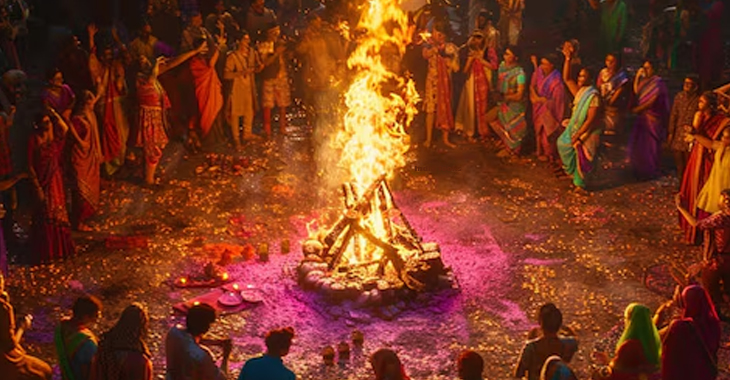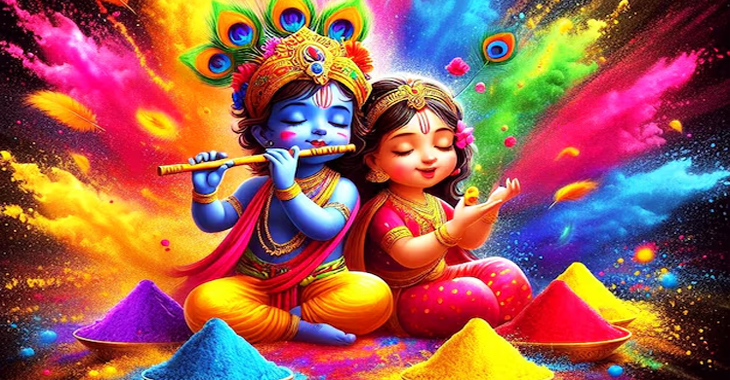Holi: A Festival of Colours and Emotions of Joy

Holi is a prominent Hindu festival celebrated as the Festival of Colours, Love, and Spring. It commemorates the eternal and divine love between the deities Radha and Krishna. Furthermore, the day represents the triumph of good over evil, commemorating Vishnu’s victory as Narasimha over Hiranyakashipu. Holi originated and is mostly celebrated in the Indian subcontinent, although it has since expanded to other parts of Asia and the Western world via the Indian diaspora.
Holi also commemorates the entrance of spring in India, the end of winter, and the blooming of romance.It’s also an invocation for a prosperous spring crop season. It lasts for a night and a day, starting on the evening of the Purnima (full moon day) falling on the Hindu calendar month of Phalguna, which falls around the middle of March in the Gregorian calendar.
The celebration has several functions, the most important of which is to mark the start of spring. In 17th-century literature, it was described as a festival that praised agriculture, good spring crops, and fertile soil. Hindus think it is the moment to celebrate spring’s vibrant colors and bid farewell to winter. Many Hindus view Holi festivities as an opportunity to reset and restore broken relationships, resolve problems, and cleanse oneself of emotional pollutants from the past.

It also has a religious purpose, as represented by the legend of Holika. Bonfires are lit the night before Holi as part of the Holika Dahan (burning of Holika) or Little Holi festival. People congregate around flames to sing and dance. The next day, Holi, also known as Dhuli in Sanskrit, or Dhulheti, Dhulandi or Dhulendi, is celebrated.
In northern India, children and youth spray coloured powder solutions (gulal) at each other, laugh, and rejoice, while adults spread dry coloured powder (abir) over their faces. Visitors to homes are first teased with colors before being fed Holi dishes (such as gujhia, shakkarpaare, matri, and dahi vada), desserts, and drinks. After playing with colors and cleaning up, folks bathe, change into clean clothes, and visit friends and family.
Kama Dahanam, like Holika Dahan, is celebrated in certain parts of India. Rangapanchami, or the festival of colours, takes place on the fifth day following Poornima (the full moon).
Holi is also a celebration of forgiveness and new beginnings, with the ritualistic goal of promoting social harmony.Groups sing and dance, with some playing drums and dholaks. Gujiya, mathri, malpuas, and other traditional delicacies are served after each stop of fun and colour play.Cold drinks, especially those infused with marijuana, are also part of the Holi celebration.
On Holi, the people of Odisha celebrate Dola or Pushpadola, in which Jagannath’s idols substitute Krishna and Radha’s. Dola Melana is honored in villages, with deity processions and bhoga offerings. “Dola yatra” was popular even before 1560, long before Holi began, and the idols of Jagannath, Balabhadra, and Subhadra were brought to the “Dolamandapa” (podium in Jagannath temple). People used to present natural colors called “abira” to the deities and use them to enhance each other’s abilities.

Barsana, a town near Mathura in Uttar Pradesh’s Braj district, celebrates Lathmar Holi in the huge Radha Rani Temple courtyard. Thousands flock to see the Lath Mar Holi, in which women beat up males with sticks as those on the sidelines go frenzied, singing Holi songs and shouting “Radhe Radhe” or “Sri Radhe Krishna“. Braj Mandal’s Holi songs are sung in pure Braj, the indigenous language.
The main day of the festival is known as “Holi”, “Rangwali Holi”, “Dol Purnima”, “Dhuleti”, “Dhulandi”, “Ukuli”, “Manjal Kuli”, “Yaosang”, “Shigmo”, “Phagwah”, or “Jajiri”.
Holi is also known as Dol Jatra (swing festival) and Boshonto Utshob in Bengal (West Bengal and Bangladesh), Phakua in Assam, Phagu Purnima in Nepal’s hilly region, Dola Jatra in Odisha, Fagua or Phagua in eastern Uttar Pradesh, western Bihar, and northwestern Jharkhand, Phagwah or Phagwa in the Caribbean (namely Trinidad and Tobago, Guyana, Suriname, and Jamaica), and Phagua in Fiji.
Holi, also known as Phagu Purnima, is a national celebration in Nepal, along with many other Hindu holidays. is observed in the Nepali month of Falgun and commemorates the stories of the Hindu god Krishna.
Holi is celebrated by Pakistan‘s tiny Hindu population. The Hindu tribes of Cholistan play the game Khido in the days leading up to Holi. They consider the game Khido to be sacred since Parhlad is said to have played it as a youngster.
Phagwah is a public holiday in Guyana, and people of all races and religions engage in the festivities. The primary event in Georgetown takes place at the Mandir at Prashad Nagar.
Holi is celebrated in Mauritius shortly after Shivaratri. It marks the start of spring, honoring good harvests and fertile land. Hindus think it is a time to celebrate spring’s vibrant colors and say goodbye to winter.
Holi is celebrated in numerous US states by mostly South Asian Americans, notably those of Indian descent. It is mainly held at Hindu temples or cultural halls. In addition to temple devotees, members of Hindu associations and volunteers help to organize the event.
In Indonesia, Indian Indonesians and Balinese Hindus celebrate Holi as a festival of colours. The main ceremonies are held in Medan and Bali.

Some colours produced and sold in India contain metal-based industrial dyes, which might cause skin problems for some people in the days following Holi. These hues are made in India, primarily by small informal firms, with no quality standards and are widely available in the market. The colors are offered without labels, so the consumer has no idea where the colors came from, what they include, or whether they are harmful.
Some organizations have initiated programs to teach youngsters how to manufacture their own Holi colours using safer, natural chemicals. Meanwhile, some commercial companies have started marketing “herbal” dyes, which are far more expensive than the harmful alternatives.
Let us come together to celebrate the festival of love and happiness – Happy Holi!
